And he was quite insistent about whatever he was trying to tell her (I have my suspicions about what it was).
Exactly four years ago tomorrow I photographed a mated pair of Sandhill Cranes as they came in to land in a verdant agricultural field in Wayne County, Utah. They intended to land among a group of other cranes already feeding in the field and I had the distinct (though possibly incorrect) impression that the male was providing his mate with explicit instructions on how she should conduct herself among all the “randy” males already on the ground.
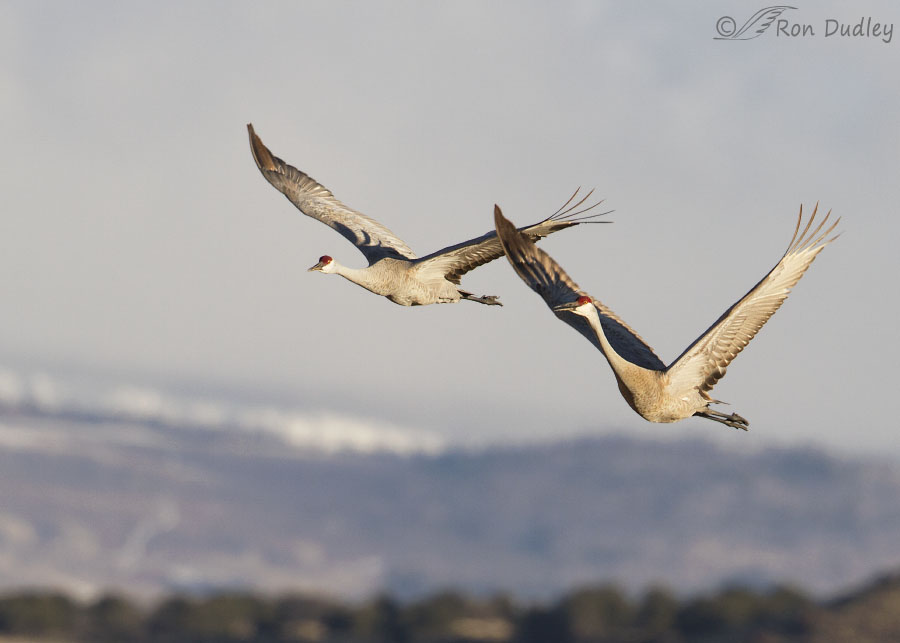
1/1250, f/8, ISO 500, Canon 7D, Canon EF 500mm f/4L IS II USM + EF 1.4 III Extender, not baited, set up or called in
They were still far away when I first locked focus on them but I include this photo to provide readers a sense of the landscape below them.
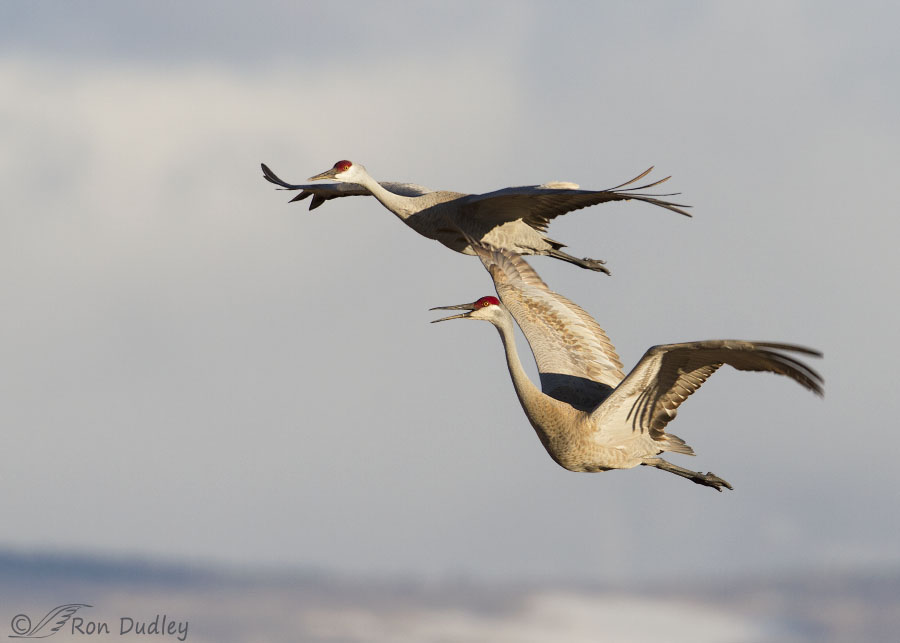
1/1000, f/8, ISO 500, Canon 7D, Canon EF 500mm f/4L IS II USM + EF 1.4 III Extender, not baited, set up or called in
As they approached their intended landing area the larger male assumed an exaggerated flight pose and began to call insistently to his mate. Based on his posture and behavior I’m convinced he was “talking” to her rather than to the other cranes on the ground.
1/100, f/8, ISO 500, Canon 7D, Canon EF 500mm f/4L IS II USM + EF 1.4 III Extender, not baited, set up or called in
Their approach was slow and he continued to call to her the entire time. I love the comparison between her typical flight posture and his exaggerated pose with his arched body and raised head and neck as he directs his calls toward his mate.
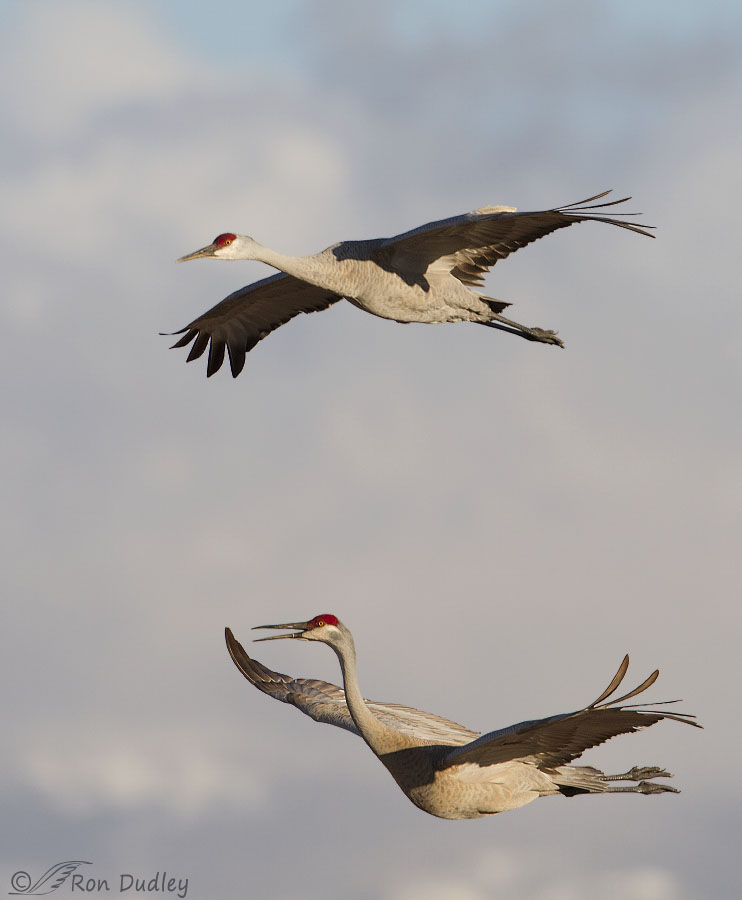
1/1000, f/8, ISO 500, Canon 7D, Canon EF 500mm f/4L IS II USM + EF 1.4 III Extender, not baited, set up or called in
As they descended and approached their destination he seemed to be deliberately keeping his body between his mate and the ground as if he was trying to direct her to a specific landing spot that pleased him (though of course I don’t know that for fact).
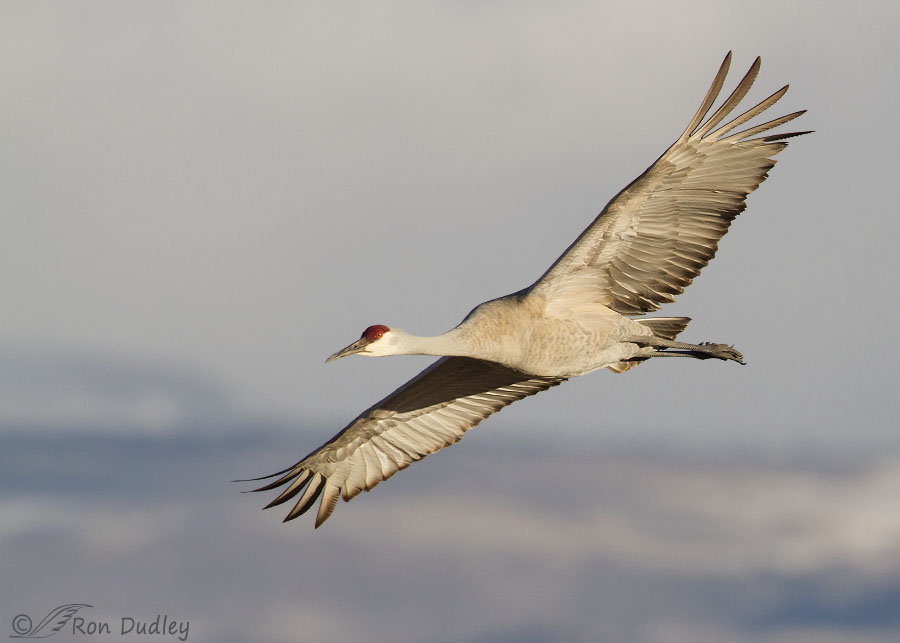
1/2000, f/8, ISO 500, Canon 7D, Canon EF 500mm f/4L IS II USM + EF 1.4 III Extender, not baited, set up or called in
As they got even closer I could only keep one of the two birds in frame and I can’t remember if this one was the male or the female (based on a comment below from Sallie Reynolds I’m now convinced that this is the female). Here the crane tipped its body toward the rising sun in the east and provided good light and detail on its ventral side which minimized all those dark shadows we see in the previous images.
I wish I knew precisely what he was trying to communicate to her during their approach but I did have the distinct impression that he was guiding her to a specific landing spot and perhaps even giving her guidance about how she should conduct herself on the ground amongst all those potentially competing males.
Ron
R.I.P. Stephen Hawking.


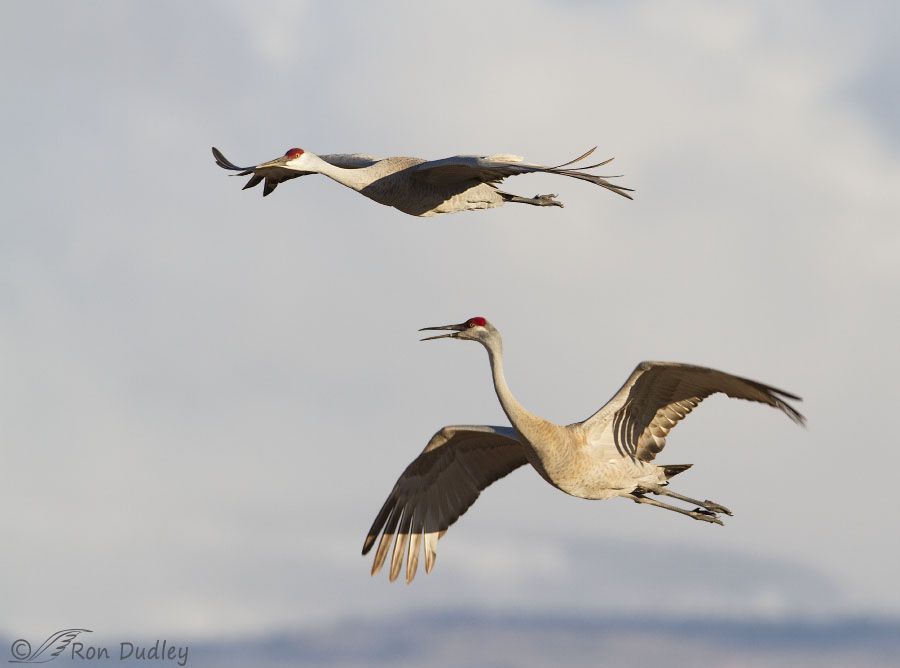
At least he was keeping one eye on the “road,” and not texting his message to her!
We have sandhill cranes here in Florida. A few years ago, I saw 2 sandhills jumping and dancing in the air around each other…I realized they were doing a mating dance! It was beautiful!
I’ve seen (and photographed) that behavior too, Adele.
BEAUTIFUL…especially like the last…
Thanks, Patty.
And people say that it is women who talk too much. Is it wrong of me to hope that she ignored his instructions, and scurried off and had fun when they landed?
Vale Stephen Hawkins indeed. And how wrong the doctors were who told him when he was first diagnosed at 21 that he had a life expectancy of two years. And he made the most of every one of those years.
Who knows, EC – maybe she did just that. I don’t think I paid her any attention after she landed near the group.
They are a pretty bird in flight. I watched several years ago when they the cranes flew from Minn. south, till the funding was cut. Enjoyed watching those new hatching made the trip home.
🙂
Great series! I have enjoyed capturing the cranes at Staten Island south of Sacramento this season. Did you use back button focus to maintain focus while tracking flight?
Thank you for your ever awe inspiring captures and narratives.
Jacquie
Thanks, Jacquie. Yes, I’m nearly always using bb autofocus for birds.
Under another 8″ of wet snow on top of 16″ of powder and it is still snowing from time to time, I decided I better grab another mug of coffee and sit down to a delightful read of your blog! I agree with Marty K, that that is probably exactly what she is saying/thinking!
Beautiful shot Ron.
Thanks, Dick. Good luck with all your snow!
Stay warm, Dick!
Splendid stuff. This paper, on vocalizations, might answer some questions. https://digitalcommons.unl.edu/nacwgproc/227/. I’d guess the authors would provide copies gratis.
Thanks, Martha. I’ll check it out.
And people say females talk too much! I’ll bet he’s telling her he didn’t need to ask for directions and she’s thinking to herself, “Yeah, right. Then why are we the last ones here?” 😉
I stumbled across the news about Professor Hawking last night. So sad he’s gone, but what an amazing life he led. Interesting coincidence that he died on Einstein’s birthday.
And he was born on Galileo’s death anniversary.
Made me smile, Marty.
Yes, about the coincidence. And that most folks learned about Hawking’s death on Pi day (today).
Great shots as usual Ron. I love your observations and discussion of bird behaviors and in this case I agree with you that there appears to be a one sided discussion of landing instructions. Interesting that there is no response from the female. I wish that was the case when I am giving my wife directions when she is driving. Please don’t be offended ladies, my wife is usually right.
I see similar communication between eagles that I am watching around a nest near my home.
I have a bunch of other photos of this pair in flight and she wasn’t vocalizing in any of those shots either. Thanks, Reid.
Their caps seem a deeper shade of red than those on the Sandhills I watched at Bosque del Apache in New Mexico–does that more vivid coloration appear during mating season? Every November
and in early February ( during migration along the Rio Grande ) the calls of thousands of Sandhills thrilled me to the bone–I felt thankful to have lived another season just to be able to hear that
wonderful chorale again !
I don’t know, Kris – but it does make sense.
Beautiful photos as usual. What a lucky catch to see the unusual flight posture. I really want to go to Kearny Nebraska this spring break to see the Sandhill Crane migration. I can’t get anyone to go with me and I don’t feel comfortable driving that far alone, especially through Colorado if the weather turns bad. I still have a week to work on a few possible travel companions but it’s looking bleak, I am down to non-birdy friends and Nebraska does not have much to entice traveling that far.
I hope you find a traveling companion, April. That would be a sight to see!
PS – you might want to read Ed’s comment below. Monte Vista in CO would be a shorter drive.
Based on my experience, my guess is that even though he was trying to provide directions, she was probably ignoring him. “Stupid male……!” Fun animal behavior photography Ron. Thanks again.
Ha, you might be right, Frank! I remember similar experiences… 🙂
Spectacular series Ron!
Charlotte
Thanks, Charlotte.
Beautiful shots, Ron! 🙂 He certainly is talking to her tho I’m not sure she’s “impressed” 😉 His body position is amazing – must be “work” to talk, change the body position, fly, and keep an eye on the ground……. Amazing that Hawking lasted as long as he did – don’t think I could live physically confined like that… He was an amazing man.
Absolutely, Judy – he was a multitasker, that’s for sure.
Hawking was a very special human being in so many ways.
Lovely, Ron. The last shot seems to be the female, from the smaller red cap she is wearing.
Dang, I think you’re right, Sallie. I hadn’t even noticed that!
Great photos Ron and I think you are correct that he was talking to her in flight. The past couple of weeks I have been immersed with 20,000 Sandhill Cranes at Monte Vista NWR in Colorado. I watch as family units come into land with the flock and vocalize. I would love to learn more about their sound communications. I may bring the Telinga microphone today out there and record some voice signatures. You may have noticed when one single crane flys above the flock there is a different vocalization, I project that is probably like I did when my parents would try to lose me at a crowded event, like the State Fair and I would be calling for them 😉
Ed, I know you have vast experience with cranes so I’m very interested in your feedback. I tried to avoid being anthropomorphic in my interpretation of the intentions of his calling to her but I sure had the impression that he was guiding her to his preferred landing spot and that spot might very well be based on where other competing males were in the ground.